
Looking for How to Make Grape Jelly - Easily! With Step-by-step Photos, Recipe, Directions, Ingredients and Costs in 2025? Scroll down this page and follow the links. And if you bring home some fruit or vegetables and want to can, freeze, make jam, salsa or pickles, see this page for simple, reliable, illustrated canning, freezing or preserving directions. There are plenty of other related resources, click on the resources dropdown above. If you are having a hard time finding canning lids, I've used these, and they're a great price & ship in 2 days.
If you have questions or feedback, please let me know! There are affiliate links on this page. Read our disclosure policy to learn more.
How to Make Grape Jelly - Easily! With Step-by-step Photos, Recipe, Directions, Ingredients and Costs
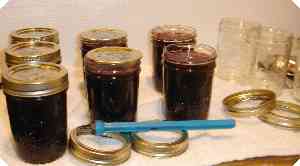 Making and canning your own grape jelly is also quite easy.
Here's how to do it, in 12 easy steps and completely illustrated. These
directions work equally well for other types of grape-like fruits.
See this page for muscadine jelly and
scuppernong jelly). If you cannot get fresh fruit, you can make jelly
from frozen or bottled juice. See this page for those
grape jelly, from juice
directions.
ANd if you don't mind the pulp; you can
make grape jam, see this page.
Making and canning your own grape jelly is also quite easy.
Here's how to do it, in 12 easy steps and completely illustrated. These
directions work equally well for other types of grape-like fruits.
See this page for muscadine jelly and
scuppernong jelly). If you cannot get fresh fruit, you can make jelly
from frozen or bottled juice. See this page for those
grape jelly, from juice
directions.
ANd if you don't mind the pulp; you can
make grape jam, see this page.
Related pages: See this page for How to make muscadine or scuppernong jelly or this page for Jam-making directions and this page for apple jelly directions!
For easy applesauce or apple butter directions, click on these links.
Ingredients
- Grapes - 5 lbs of fresh grapes, preferably fresh, but if you want to start with grape juice (5 cups bottled, without sugar added or reconstituted from frozen, without sugar), you can skip to step 7.
- Pectin - 1 package (box usually) or if you get it in bulk, 8 Tablespoons, see the directions below for specifics - (it's a natural product, made from apples and available at grocery stores (season - spring through late summer) and local "big box" stores. It usually goes for about $2.00 to $2.50 per box. You will get best results with no-sugar needed pectin, whether you choose to add sugar or not! See here for more information about how to choose the type of pectin to use.
- Sugar - About 4.5 cups of dry, granulated (table) sugar, if you use the no-sugar-needed pectin (the only type I recommend) or low sugar pectin. If you use regular pectin, you will need 7 cups of sugar. Of course, you can substitute honey, agave, stevia or Splenda; see the no-sugar recipe, click here.
- Lemon juice - normally grapes are plenty acidic... but ... once in a while, especially with very sweet, ripe grape, you may want to add 1/4 cup of lemon juice to each batch when you add the sugar... It won't make it taste any different, but it will help the pectin to gell better.
Equipment
- Large spoons and ladles,
- Jar funnel ($5 at Target, other big box stores, and often grocery stores; and available online - see this page) or order it as part of the kit with the Jar grabber .
- Jar grabber (to pick up the hot jars)- Big box stores and grocery stores sometimes carry them; and it is available online - see this page. It's a tremendously useful to put jars in the canner and take the hot jars out (without scalding yourself!). The kit sold below has everything you need, and at a pretty good price:
- Blender, food processor or juicer - Yes, you could do it manually, if are only making a small batch, are insane, or you have access to child labor.
- At least 1 large pot; I prefer 16 to 20 quart Nonstick ceramic coated pots for easy cleanup.
- Jelly strainer - see step 6 - or a colander and cheesecloth.
- 1 Water Bath Canner (a huge pot to sanitize the jars after filling (about $30 to $35 at mall kitchen stores, sometimes at big box stores and grocery stores.). Note: we sell canners and supplies here, too - at excellent prices - and it helps support this web site!
- Half pint canning jars (Grocery stores, like Publix, Kroger, Safeway carry them, as do some big box stores - about $7 per dozen 8 ounce jars including the lids and rings)
- Lids - thin, flat, round metal lids with a gum binder that seals them against the top of the jar. They may only be used once.
- Rings - metal bands that secure the lids to the jars. They may be reused many times.
Optional stuff:
- Foley Food Mill - not necessary; useful to mush up the fruit or if you want to remove seeds (for example, from blackberries) or make applesauce.
- Lid lifter (has a magnet to pick the lids out of the almost-boiling water where you sanitize them. ($4 at big box stores or it comes in the kit at left)
Grape Jelly-making Directions
This example shows you how to make grape jelly. You can use this recipe to make almost any type of jelly from the fruit juice; where there is a difference, I will point it out! The yield from this recipe is about 12 eight-ounce jars (which is the same as 6 pints).
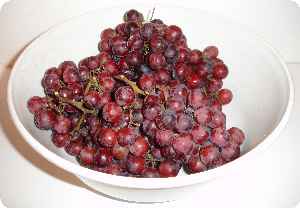 Step
1 - Pick the grapes! (or buy them already picked)
Step
1 - Pick the grapes! (or buy them already picked)
It's fun to go pick your own and you can obviously get better quality ones! You can use Concord grapes, red grapes or other grapes. Whichever you choose, you want flavorful grapes. Plain seedless white/green grapes, for example, have little flavor and make a bland jelly. Most people choose Concord grapes or red grapes. Seedless or with seeds doesn't matter, as the strainer will remove them!
I prefer to grow my own; which is really easy - but that does take some space and time.
Above are grapes that I picked at a pick-your-own farm. If you want to pick your own, here is a list and links to the pick your own farms.
Step 2 - How much fruit?
Grape Jelly can ONLY be made in rather small batches - about 6 cups at a time - like the directions on the pectin say, DO NOT increase the recipes or the grape jelly won't "set" (jell, thicken). As mentioned in the Ingredients section; you may use either 5 lbs of fresh grapes or 5 cups of grape juice (either bottled or reconstituted from frozen concentrate) without added sugar. Using grape juice is especially useful if you want to make some grape jelly in December to give away at Christmas!
Step 3 - Wash the jars and lids
Now's a good time to get the jars ready, so you won't be rushed later. The dishwasher is fine for the jars; especially if it has a "sanitize" cycle, the water bath processing will sanitize them as well as the contents! If you don't have a dishwasher with a sanitize cycle, you can wash the containers in hot, soapy water and rinse, then sanitize the jars by boiling them 10 minutes, and keep the jars in hot water until they are used.
 NOTE: If a canning recipe calls for 10 minutes or more of process time in the canner, then the jars do not need to be "sanitized" before filling them.
But really, sanitizing them first is just good hygeine and common sense! See this page for more detail about cleaning and sanitizing jars and lids.
NOTE: If a canning recipe calls for 10 minutes or more of process time in the canner, then the jars do not need to be "sanitized" before filling them.
But really, sanitizing them first is just good hygeine and common sense! See this page for more detail about cleaning and sanitizing jars and lids.
Put the lids into a pan of hot, but not quite boiling water (that's what the manufacturer's recommend) for 10 minutes, and use the magnetic "lid lifter wand" to pull them out.
Leave the jars in the dishwasher on "heated dry" until you are ready to use them. Keeping them hot will prevent the jars from breaking when you fill them with the hot jelly.
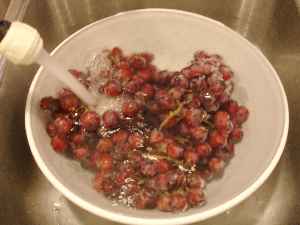 Step
4 -Wash the grapes!
Step
4 -Wash the grapes!
I'm sure you can figure out how to wash the grapes in a large bowl under running plain cold water.
Pick out any stems and leaves that became mixed in!
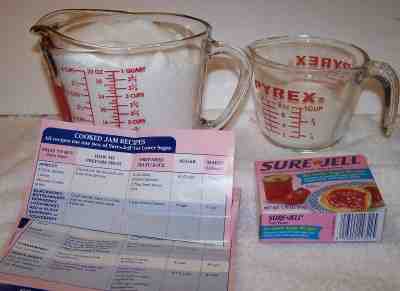 Step
5 - Measure out the sugar
Step
5 - Measure out the sugar
Check the directions with the pectin; typically, it is 7 cups of sugar to 5 cups of grape juice and one box of regular pectin. You can use about half as much sugar if you use the "no-sugar-needed" pectin. The precise measurements are found in each and every box of pectin sold. Mix the dry pectin with about 1/4 cup of the sugar and keep this separate from the rest of the sugar. If you are not using sugar, you will just have to stir more vigorously to prevent the pectin from clumping.
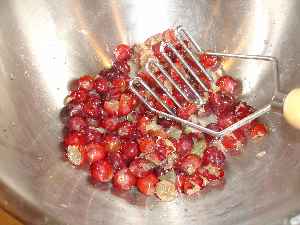 Step
6 - Crush or chop the grapes
Step
6 - Crush or chop the grapes
You mush the grapes to release the juice. A potato masher is useful to help crush them. But if you really want to ,make it easy, just use your food processor or chopper, just a few chops, don't pureee them. OR a juicer. A steam juicer really does a good job of it.
Obviously, if you use seedless grapes, you can use a
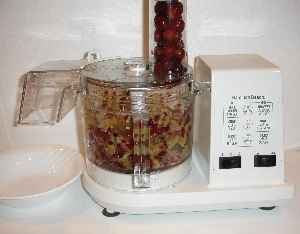 blender
or chopper. If you chop grapes with seeds in them, you will
get bits of seeds in the jelly.
blender
or chopper. If you chop grapes with seeds in them, you will
get bits of seeds in the jelly.
The bottom line is, to make jelly, we will need to crush the grapes well so we can extract the juice. You will need about 5 cups of juice.
If you use a juicer, you can juice the grapes, then skip to step 8.
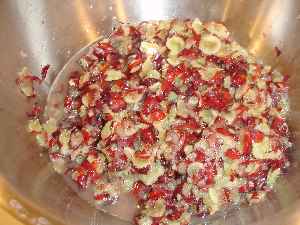 Step
7 - Heat the crushed grapes on the stove
Step
7 - Heat the crushed grapes on the stove
Put the grap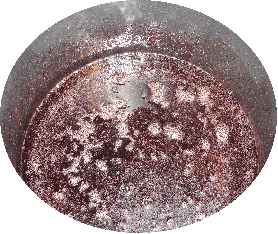 es
in a pot and add enough water to just cover the grapes. Put the crushed
grapes in a big pot on the stove over medium to high heat (stir often
enough to prevent burning) for until it starts to boil, then reduce the
heat and simmer for 10 minutes. We just want to soften the skins to help
release the juice and break down some of the fruit to help it pass through
our juice strainer.
es
in a pot and add enough water to just cover the grapes. Put the crushed
grapes in a big pot on the stove over medium to high heat (stir often
enough to prevent burning) for until it starts to boil, then reduce the
heat and simmer for 10 minutes. We just want to soften the skins to help
release the juice and break down some of the fruit to help it pass through
our juice strainer.
Step 8 - Sieve the cooked grapes
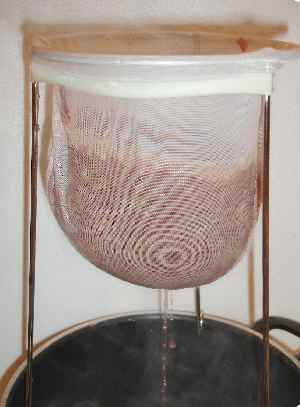 You
can either put the soft cooked grapes through a jelly strainer (about
$9.00, see ordering at right) which results in the most clear jelly and
is easiest to use, or pour them through cheesecloth in a colander. Or if
you don't mind chunky jelly, just let the juice stand for 20 minutes,
and decant (pour off) the clear liquid to use and leave the solids
behind.
You
can either put the soft cooked grapes through a jelly strainer (about
$9.00, see ordering at right) which results in the most clear jelly and
is easiest to use, or pour them through cheesecloth in a colander. Or if
you don't mind chunky jelly, just let the juice stand for 20 minutes,
and decant (pour off) the clear liquid to use and leave the solids
behind.
You may also want to run the crushed cooked grapes through a Foley food mill (about $20 - see this page) BEFORE the jelly strainer - it helps to extract more juice and jet out the large skins that will clog the strainer. It's not necessary, but helps you get the most out of the grapes.
Some people prefer to simply run the juice through a blender to finely puree the pulp, skins and all. That's fine, and certainly easier (and faster) than using a fabric seive.
If you need a stopping point and want to finish up the next day, this is a good place. Sometimes, jelly gets crystals, called tartrate crystals, forming in the jelly. They're not harmful and don't affect the taste, but some people don't like the appearance. I rarely even see them! But if you do, let juice stand in a cool place overnight, then strain through two thicknesses of damp cheesecloth to remove any crystals that have formed.
Comments from a visitor on August 22, 2011: "I just thought I would tell you a cost saving item. I use the paint filters at Sherwin Williams paint stores they are so easy and economical. They can also be washed and reused multiple times. Yesterday I worked up about three gallons of grapes and I used the 5 gallon size (they come in all sizes). "
Step 9 - Add the pectin to the hot strained juice and bring to a full boil
 Stir the pectin into the grape juice and put the mix in a big pot on
the stove over medium to high heat (stir often enough to prevent burning).
It should take about 5 to 10 minutes to get it to a full boil (the kind
that cannot be stirred away).
Stir the pectin into the grape juice and put the mix in a big pot on
the stove over medium to high heat (stir often enough to prevent burning).
It should take about 5 to 10 minutes to get it to a full boil (the kind
that cannot be stirred away).
Notes about pectin: I usually add about 25% - 30% more pectin (just open another pack and add a little) or else the jelly is runnier than I like. With a little practice, you will find out exactly how much pectin to get the thickness you like.
Another tip: use the low sugar or no-sugar pectin. It cuts the amount of sugar you need from 7 cups per batch to 4 cups. And it tastes even better! On the other hand; I still add some sugar, even with the No-sugar pectin. With no added sugar, the batches always turned out runny and bland. You might want to try using the low sugar recipe with a mixture of sugar and Stevia (or if you prefer, agave, honey or Splenda); that could work, but you do get the best results with sugar.

Is your jelly too runny? Pectin enables you to turn out perfectly set jelly
every time. Made from natural apples, there are also natural no-sugar
pectins that allow you to reduce the sugar you add by half or even eliminate
sugar.!
Get canning jars, rings, lids and pectin deliverd:
Step 10 - Get the lids warming in hot (but not boiling) water
If you didn't do so already, put the lids into a pan of hot water for at least several minutes; to soften up the gummed surface and clean the lids.



Need lids, rings and replacement jars?
Get them all here, delivered direct to your home, at the best prices on the internet!
Step 11 - Add the remaining sugar and bring to a boil
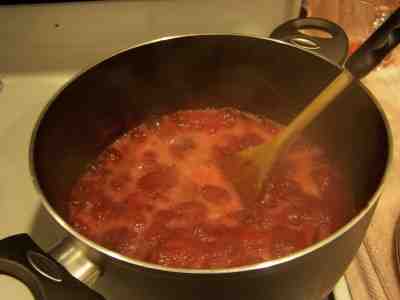 When
the grape-pectin mix has reached a full boil, add the rest of the sugar
(about 6 and 3/4 cups of sugar per 5 cup batch of grape juice; 4 cups of
sugar if you are using the low or no-sugar pectin) and then bring it back
to a boil and boil hard for 1 minute.
When
the grape-pectin mix has reached a full boil, add the rest of the sugar
(about 6 and 3/4 cups of sugar per 5 cup batch of grape juice; 4 cups of
sugar if you are using the low or no-sugar pectin) and then bring it back
to a boil and boil hard for 1 minute.
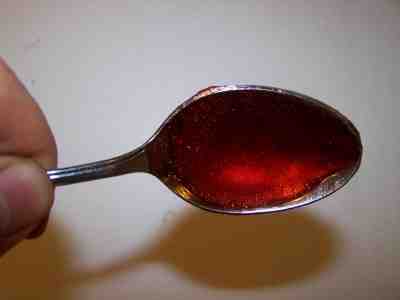 Step
12 - Testing for "jell" (thickness)
Step
12 - Testing for "jell" (thickness)
I keep a metal tablespoon sitting in a glass of ice water, then take a half spoonful of the mix and let it cool to room temperature on the spoon. If it thickens up to the consistency I like, then I know the jelly is ready. If not, I mix in a little more pectin (about 1/4 to 1/2 of another package) and bring it to a boil again for 1 minute.
 Step
13 - Fill the jars and put the lid and rings on
Step
13 - Fill the jars and put the lid and rings on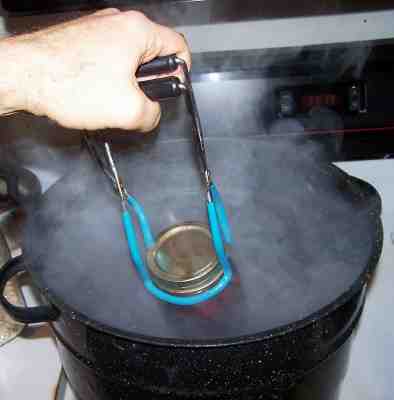
Fill them to within 1/4-inch of the top, wipe any spilled jelly off the top, seat the lid and tighten the ring around them. Then put the filled jars into the canner!
This is where the jar tongs come in really handy!
Step 14 - Process the jars in the boiling water bath
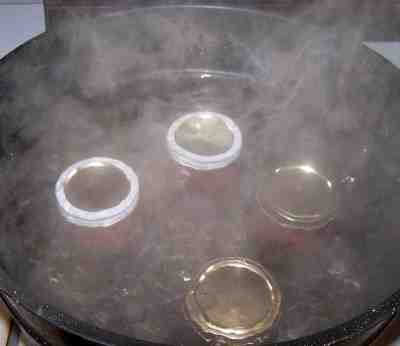 Keep
the jars covered with at least 2 inches of water. Keep the water
boiling. In general, boil them for 5 minutes, which is what SureJell
(the makers of the pectin) recommend. I say "in general" because
you have to process (boil) them longer at higher altitudes than sea
level, or if you use larger jars, or if you did not sanitize the jars
and lids right before using them. The directions inside every box
of pectin will tell you exactly - and see the Table below for altitude
differences. The directions on the pectin tend to be pretty
conservative. Note: Some people don't even boil the jars; they
just ladle it hot into hot jars, put the lids and rings on and invert
them, but putting the jars in the boiling water bath REALLY helps to
reduce spoilage! To me, it makes little sense to put all the working
into making the jelly and then not to process the jars to be sure they
don't spoil!
Keep
the jars covered with at least 2 inches of water. Keep the water
boiling. In general, boil them for 5 minutes, which is what SureJell
(the makers of the pectin) recommend. I say "in general" because
you have to process (boil) them longer at higher altitudes than sea
level, or if you use larger jars, or if you did not sanitize the jars
and lids right before using them. The directions inside every box
of pectin will tell you exactly - and see the Table below for altitude
differences. The directions on the pectin tend to be pretty
conservative. Note: Some people don't even boil the jars; they
just ladle it hot into hot jars, put the lids and rings on and invert
them, but putting the jars in the boiling water bath REALLY helps to
reduce spoilage! To me, it makes little sense to put all the working
into making the jelly and then not to process the jars to be sure they
don't spoil!
| Table 1. Recommended process time for Grape Jelly in a boiling water canner. | ||||
| Process Time at Altitudes of | ||||
| Style of Pack | Jar Size | 0 - 1,000 ft | 1,001 - 6,000 ft | Above 6,000 ft |
| Hot | Half-pints or Pints |
5 min | 10 | 15 |
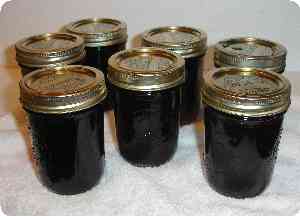 Step
15 - Remove and allow the jars to cool - Done!
Step
15 - Remove and allow the jars to cool - Done!
Lift the jars out of the water with your jar lifter tongs and let them cool without touching or bumping them in a draft-free place (usually takes overnight) You can then remove the rings if you like, but if you leave them on, at least loosen them quite a bit, so they don't rust in place due to trapped moisture. Once the jars are cool, you can check that they are sealed verifying that the lid has been sucked down. Just press in the center, gently, with your finger. If it pops up and down (often making a popping sound), it is not sealed. If you put the jar in the refrigerator right away, you can still use it. Some people replace the lid and reprocess the jar, then that's a bit iffy. If you heat the contents back up, re-jar them (with a new lid) and the full time in the canner, it's usually ok.
Once cooled, they're ready to store. I find they last up to 12 months. But after about 6 to 8 months, they get darker in color and start to get runny. They still are safe to eat, but the flavor and texture aren't as good. So eat them in the first 6 months after you prepare them!
Summary - Cost of Making Homemade Grape Jelly - makes 8 jars, 8 oz each** |
||||
| Item | Quantity | Cost in 2025 | Source | Subtotal |
| fresh whole grapes | 10 cups | $10.00/gallon | Pick your own | $12.00 |
| Canning jars (8 oz size), includes lids and rings | 8 jars | $11/dozen 8 oz jars or $0.92/jar Lids alone are about $ per dozen |
Grocery stores, like Public, Kroger, Safeway and sometimes, Big Lots, local hardware stores and big box stores | $5.67 |
| Sweetener - see step 4 | 4 cups | $2.25 | Grocery stores, like Public, Kroger, Safeway and sometimes, Big Lots, local hardware stores and big box stores | $2.25 |
| Pectin (no-sugar or low sugar, dry) | 1 and a third boxes * | $2.50 per box |
Publix, Kroger |
$3.33 |
| Total | $23.25 total or about $2.90 per jar (if you already have the jars, and just need new lids: $2.20 per jar |
|||
| * pectin use varies - blackberry
jam needs very little, raspberry a little more, strawberry the most.
** - This assumes you already have the pots, pans, ladles,, and reusable equipment. Note that you can reuse the jars! Many products are sold in jars that will take the lids and rings for canning. For example, Classico Spaghetti sauce is in quart sized jars that work with Ball and Kerr lids and rings- some authorities do not recommend these, saying they are more prone to break, and while I have found that is true of mayonnaise jars, I have found the Classico spaghetti jars to be pretty sturdy. |
||||
Other Equipment:
|
From left to right:
|
Canning kit with Stainless Steel Steam Rack,Canning Funnel, Jar Lifter, Jar Wrench, Lid Lifter, Canning Tongs, Bubble Remover Tool |
 |
Frequently Asked Questions
Q. I was reading the instructions on making grape jelly. We have a super-duper juicer that we can run the grapes through and skip the grape-food processor/ crushing steps, but is that a suitable thing to do?
A. Sure, that ought to work great!
Q. I don't have a jelly sieve, so you suggest cheesecloth (which I do have). Will the jelly come out clear using cheesecloth (even doubled up). I really don't want to use a pillow case as I've heard is the way to go. Will cheesecloth do the trick?
Yup! It just depends what you want to achieve. The finer the cloth, the more clear the final product. But that also reduces the yield, and the "cloudiness" is actually bits of fruit, which I like!
Comments and tips
- Comments from a visitor on October 08, 2013: "I used your instructions to make my first batch of grape jelly.. I've never made jelly of any type before and this year I had a ton of grapes on my vine so I got brave and attempted it..:D It worked out fabulously and I wanted to say Thank you for your great instructions.. :D Now I am making my third batch after my family and friends loved it so much an brought me over their grapes!! :D
- Comments from a visitor on September 03, 2012: "I tried your grape jelly recipe. It is the first time I have made grape jelly as my brother's new home has a concord grape vine. Your recipe worked amazingly!! I used the no-sugar bernardin gelatin and liquid stevia (4 eye droppers full). My husband is borderline diabetic, and I am allergic to aspartame and the other artifical sweeteners. It is a little more tart than some may like, but my husbands likes the taste,... he was my taste tester for sweetness. Thank you for posting the recipe. Bonnie Perreault" (NOTE from Blake - Substituting Stevia for sugar will make it much more tart, but it still works!)
- Comments from a visitor on September 18, 2009: "Great time making concord grape jelly for the first time. I did not have all the tools but it worked out- I guess. the spoon trick to test the jelly was the trick of the day. I got 8 8oz jars out of my grape vine in the back yard. Nice easy to follow and the pictures helped me too. House smelled great for awhile ( until the kids got home ) I'm going to post all of the pictures on my Facebook page sometime soon. Thanks again."
Looking for canning equipment and supplies?
Water bath canner with a jar rack
Pressure canners for gas, electric and induction stoves: Presto 23Qt or T-fal 22Qt
Canning scoop (this one is PERFECT)
Ball Blue book (most recent version)
Jars: 8oz canning jars for jams
Find Other types of farms:
Farm markets and roadside stands
Road trips and camping resources
Local Honey, apiaries, beekeepers
Consumer fraud and scams information
Home canning supplies at the best prices on the internet!
Maple Syrup Farms, sugarworks, maple syrup festivals
Environmental information and resources
Farms For Your Event for birthday parties, weddings, receptions, business meetings, retreats, etc.
Festivals - local fruit and vegetable festivals
Get the
most recent version of
the Ball Blue Book
With this Presto 23 quart pressure canner and pressure cooker, you can "can" everything, fruits, vegetables, jams, jellies, salsa, applesauce, pickles, even meats, soups, stews. Model 01781

You can make jams, jellies, can fruit, applesauce, salsa and pickles with water bath canners, like this Granite Ware 12-Piece Canner Kit, Jar Rack, Blancher, Colander and 5 piece Canning Tool Set


